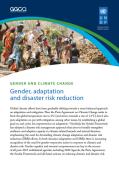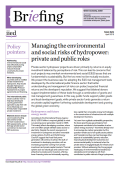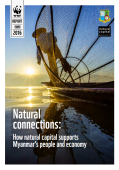

Climate change will affect all types of infrastructure, including energy, transport and water. Rising temperatures, increased flood risk and other potential hazards will threaten the reliable and efficient operation of these networks, with potentially large economic and social impacts. Decisions made now about the design, location and operation of infrastructure will determine how resilient they will be to a changing climate.
This paper provides a framework for action aimed at national policymakers in OECD countries to help them ensure new and existing infrastructure is resilient to climate change. It examines national governments’ action in OECD countries, and provides recent insights from professional and industry associations, development banks and other financial institutions on how to make infrastructure more resilient to climate change.

Global climate efforts have been gradually shifting towards a more balanced approach on adaptation and mitigation. Thus the Paris Agreement on Climate Change seeks to limit the global temperature rise to 2˚C (and strives towards a rise of 1.5˚C), but it also puts adaptation on par with mitigation, among other issues, by establishing a global goal on, and cycles for, improvement on adaptation. Similarly, the Sendai Framework has adopted a disaster risk management approach that aims to broadly strengthen resilience and adaptive capacity to climate-related hazards and natural disasters, emphasizing the need for dovetailing climate change adaptation and disaster risk reduction (DRR) efforts. In both domains (adaptation and DRR), there is increasing recognition of the need for gender-responsive action in response to climatic and disaster risk. Gender equality and women’s empowerment are key to the success of all post-2015 multilateral agendas, including 2030 Agenda, the Paris Agreement, the Sendai Framework, and all future actions on reducing climatic and disaster risk.

Private sector hydropower projects are driven primarily by returns on equity investment balanced by perceptions of risk. This can lead to concerns that such projects may overlook environmental and social (E&S) issues that are fundamental to sustainability.
But the two need not be mutually exclusive. We present the business case for adopting the E&S risk management tools developed by the international public finance sector: that better understanding and management of risks can protect expected financial returns and the developer’s reputation. We suggest that bilateral donors support implementation of these tools through a combination of grants and risk management guarantees. In this way, public funds support public goods and local development goals, while private sector funds generate a return on private capital, together furthering sustainable development and growing the global green economy.

Myanmar’s natural assets – including its forests, soils and coastal waters and the biodiversity they embody – makes up its natural capital, providing critical benefits to the Myanmar people.
Benefits are helping to protect them against natural hazards and ensuring reliable sources of clean water for drinking and irrigation as well as opportunities for ecotourism. The assessment presented in this report shows where and how Myanmar’s natural capital contributes to clean and reliable drinking water sources, reduced risks from floods inland and storms along the coasts, and to maintaining the functioning of reservoirs and dams by preventing erosion. The results highlight areas that provide high levels of ecosystem services, where natural capital provides the greatest benefits to people and infrastructure. The natural capital assessment provided here can support development and management decisions that launch Myanmar on a more sustainable and inclusive path toward economic development.
